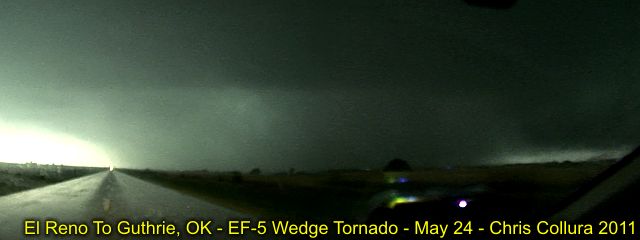Brian McKibben
EF3
Norman NWS has upgraded the Calumet-El Reno-Piedmont-Guthrie tornado to an EF-5.
The topic of discussion is their use of mobile radar to provide the EF-5 designation.
It is my understanding they measured a 125 m/s wind at 62 meters above the ground near the Calumet exit on I-40. Once extrapolated to the ground winds were likely above 210 mph.
I think the results of this field study show the flaws in the Enhanced Fujita Scale. If not for the mobile radar sampling the storm at the exact place it did, this storm would likely be rated as an EF-4 since the homes that were destroyed were not structurally able to withstand winds of EF-4 magnitude.
It is plausible that all three significant tornadoes in Oklahoma on 05-24-2011 were EF-5s, but not all of them had mobile radars sampling the storm. I heard that each significant tornado completely wiped houses off their foundations, but again the houses weren't built strong enough to withstand EF-4 winds.
STORM 3... CALUMET-EL RENO-PIEDMONT-GUTHRIE
PRELIMINARY DATA...
EVENT DATE: MAY 24, 2011
EVENT TYPE: TORNADO
EF RATING: EF-5
ESTIMATED PEAK WINDS (MPH): GREATER THAN 210 MPH
INJURIES/FATALITIES: UNKNOWN/9
EVENT START LOCATION AND TIME: 4 ESE HINTON 3:50 PM CDT
EVENT END LOCATION AND TIME: 4 NE GUTHRIE 5:35 PM CDT
DAMAGE PATH LENGTH (IN MILES): 65 MILES
DAMAGE WIDTH: TO BE DETERMINED
NOTE: RATING BASED ON UNIVERSITY OF OKLAHOMA MOBILE DOPPLER RADAR
MEASUREMENTS.
The topic of discussion is their use of mobile radar to provide the EF-5 designation.
It is my understanding they measured a 125 m/s wind at 62 meters above the ground near the Calumet exit on I-40. Once extrapolated to the ground winds were likely above 210 mph.
I think the results of this field study show the flaws in the Enhanced Fujita Scale. If not for the mobile radar sampling the storm at the exact place it did, this storm would likely be rated as an EF-4 since the homes that were destroyed were not structurally able to withstand winds of EF-4 magnitude.
It is plausible that all three significant tornadoes in Oklahoma on 05-24-2011 were EF-5s, but not all of them had mobile radars sampling the storm. I heard that each significant tornado completely wiped houses off their foundations, but again the houses weren't built strong enough to withstand EF-4 winds.
STORM 3... CALUMET-EL RENO-PIEDMONT-GUTHRIE
PRELIMINARY DATA...
EVENT DATE: MAY 24, 2011
EVENT TYPE: TORNADO
EF RATING: EF-5
ESTIMATED PEAK WINDS (MPH): GREATER THAN 210 MPH
INJURIES/FATALITIES: UNKNOWN/9
EVENT START LOCATION AND TIME: 4 ESE HINTON 3:50 PM CDT
EVENT END LOCATION AND TIME: 4 NE GUTHRIE 5:35 PM CDT
DAMAGE PATH LENGTH (IN MILES): 65 MILES
DAMAGE WIDTH: TO BE DETERMINED
NOTE: RATING BASED ON UNIVERSITY OF OKLAHOMA MOBILE DOPPLER RADAR
MEASUREMENTS.


